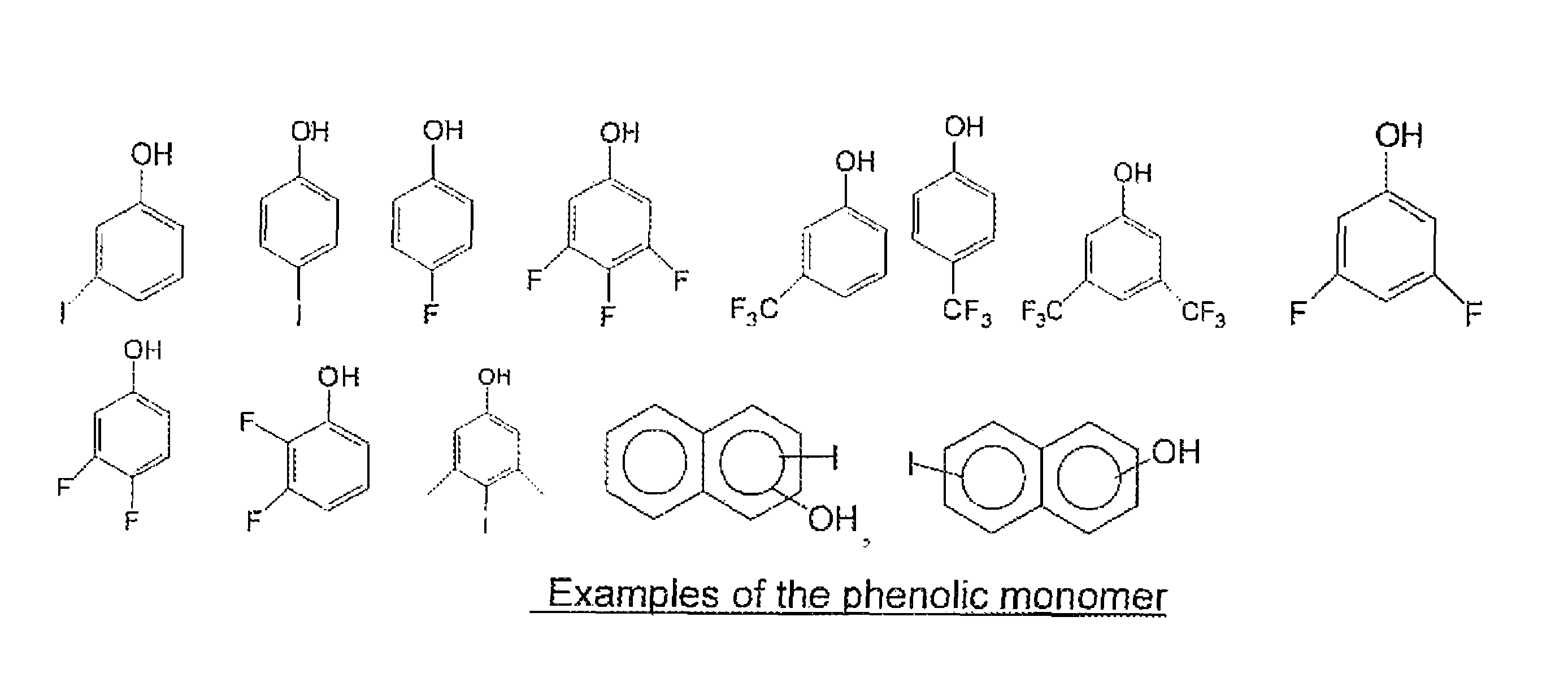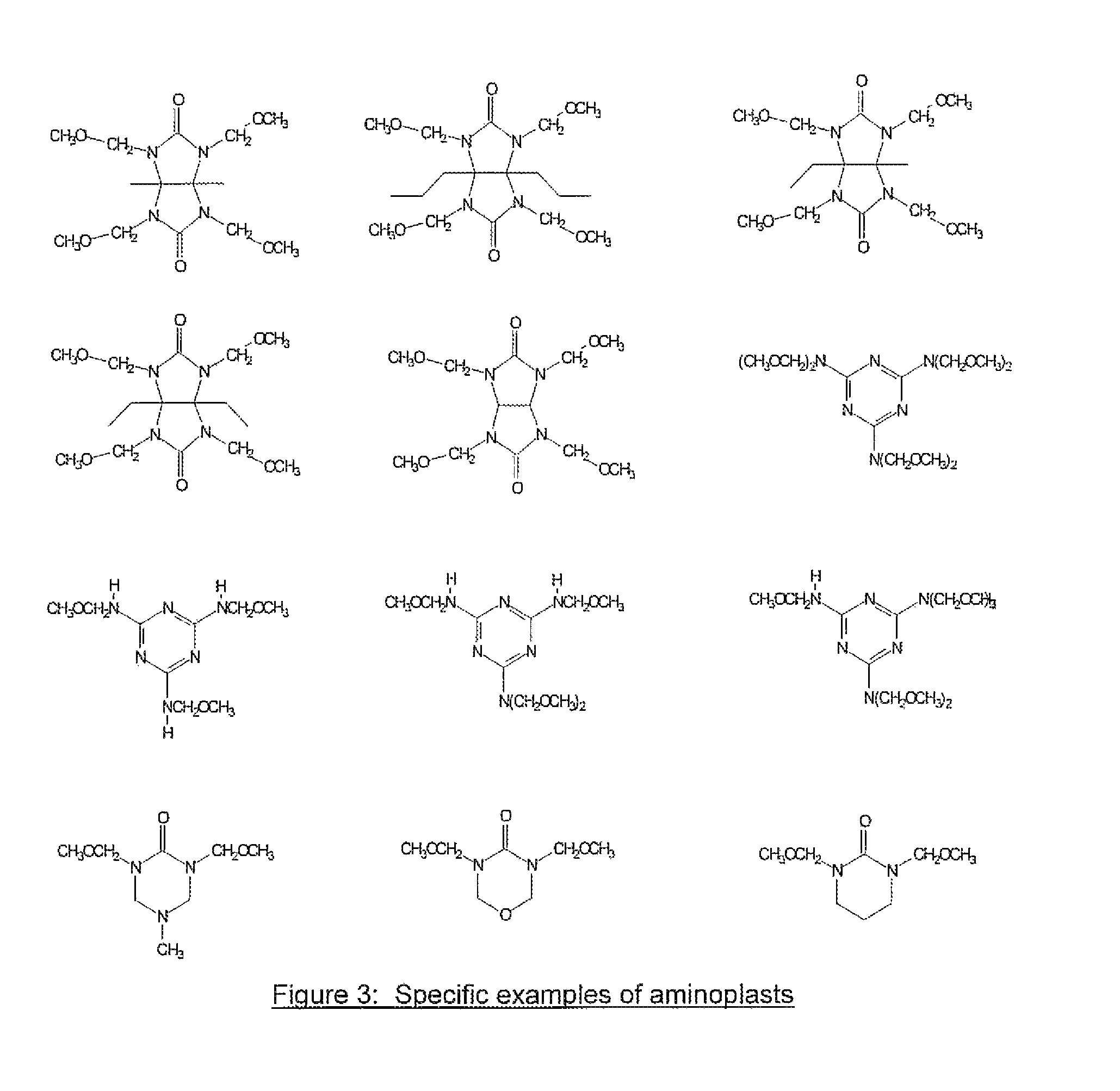Underlayer coating composition and processes thereof
- Summary
- Abstract
- Description
- Claims
- Application Information
AI Technical Summary
Benefits of technology
Problems solved by technology
Method used
Image
Examples
example 1
[0059]30 grams of tetramethoxymethyl glycoluril, 5.3 grams of 4-fluorophenol, 30 ml of tetrahydrofuran(THF) and 40 ml of propylene glycol methyl ether acetate (PGMEA) were charged into a flask with a thermometer, mechanical stirrer and a cold water condenser. After a catalytic amount of para-toluenesulfonic acid monohydrate (0.35 g) was added, the reaction was maintained at 80° C. for 4 hrs. The reaction solution was then cooled to room temperature and filtered. The filtrate was slowly poured into distilled water while stirring to precipitate the polymer. The polymer was collected by filtration. After drying, the polymer was re-dissolved in THF and precipitated in water. The polymer was filtered, washed thoroughly with water and dried in a vacuum oven. 13.2 g of polymer product was obtained with a weight average molecular weight of about 8,100 g / mol. Fluorine content in the polymer was 2.0% as determined by elemental analysis.
example 2
[0060]30 grams of tetramethoxymethyl glycoluril, 10.4 grams of 4-iodophenol, 40 ml of THF and 40 ml of PGMEA were charged into a flask with a thermometer, mechanical stirrer and a cold water condenser. After a catalytic amount of para-toluenesulfonic acid monohydrate (0.35 g) was added, the reaction was maintained at 80° C. for about 7 hrs. The reaction solution was then cooled to room temperature and filtered. The filtrate was slowly poured into distilled water while stirring to precipitate the polymer. The polymer was collected by filtration. After drying, the polymer was re-dissolved in THF and precipitated in water. The polymer was filtered, washed thoroughly with water and dried in a vacuum oven. 18.0 g of the polymer product was obtained with a weight average molecular weight of about 2,200 g / mol. Iodine in the polymer was 21.1% as determined by elemental analysis.
example 3
[0061]30 grams of tetramethoxymethyl glycoluril, 10.4 grams of 3-iodophenol, 40 ml of THF and 40 ml of PGMEA were charged into a flask with a thermometer, mechanical stirrer and a cold water condenser. After a catalytic amount of para-toluenesulfonic acid monohydrate (0.3 g) was added, the reaction was maintained at 80° C. for about 7 hrs. The reaction solution was then cooled to room temperature and filtered. The filtrate was slowly poured into distilled water while stirring to precipitate the polymer. The polymer was collected by filtration. After drying, the polymer was re-dissolved in THF and precipitated in water. The polymer was filtered, washed thoroughly with water and dried in a vacuum oven. 24.0 g of polymer product was obtained with a weight average molecular weight of about 3,500 g / mol. Iodine in the polymer was 21.7% as determined by elemental analysis. The EUV absorption was calculated to be 7.7 / g based on elemental analysis of the polymer and by assigning a known atom...
PUM
| Property | Measurement | Unit |
|---|---|---|
| refractive index | aaaaa | aaaaa |
| refractive index | aaaaa | aaaaa |
| temperatures | aaaaa | aaaaa |
Abstract
Description
Claims
Application Information
 Login to View More
Login to View More - R&D
- Intellectual Property
- Life Sciences
- Materials
- Tech Scout
- Unparalleled Data Quality
- Higher Quality Content
- 60% Fewer Hallucinations
Browse by: Latest US Patents, China's latest patents, Technical Efficacy Thesaurus, Application Domain, Technology Topic, Popular Technical Reports.
© 2025 PatSnap. All rights reserved.Legal|Privacy policy|Modern Slavery Act Transparency Statement|Sitemap|About US| Contact US: help@patsnap.com



